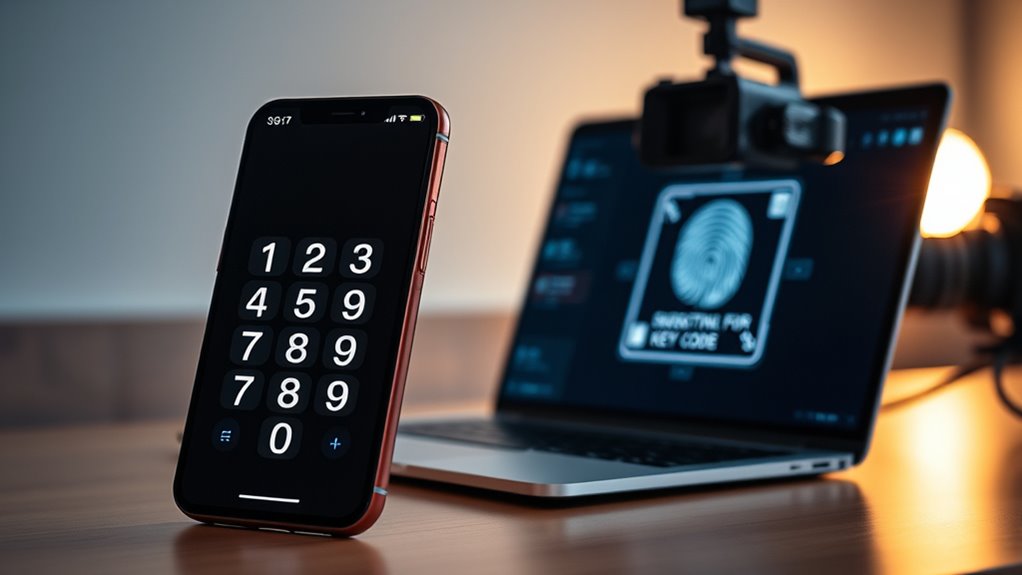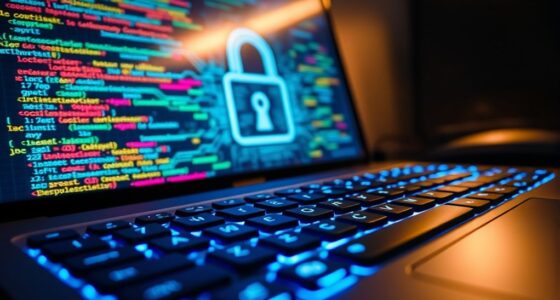Two-factor authentication (2FA) combines two different verification methods, like a password and a fingerprint, to secure your account. Multi-factor authentication (MFA) expands this by using even more methods, providing higher security. While 2FA is effective for many users, MFA offers stronger protection, especially in high-risk environments. Balancing security and convenience is key, and exploring these options further can help you choose the best method for your needs.
Key Takeaways
- Two-factor authentication (2FA) uses two different verification methods, while multi-factor authentication (MFA) involves three or more.
- MFA offers higher security by combining multiple diverse factors beyond just two.
- 2FA typically includes a password and a second factor like a code or biometric; MFA adds additional layers such as behavioral analysis.
- Implementing MFA can be more complex and costly but provides stronger protection against attacks.
- Both methods improve security, but MFA provides a more comprehensive defense by increasing layers of verification.
Understanding Authentication Methods
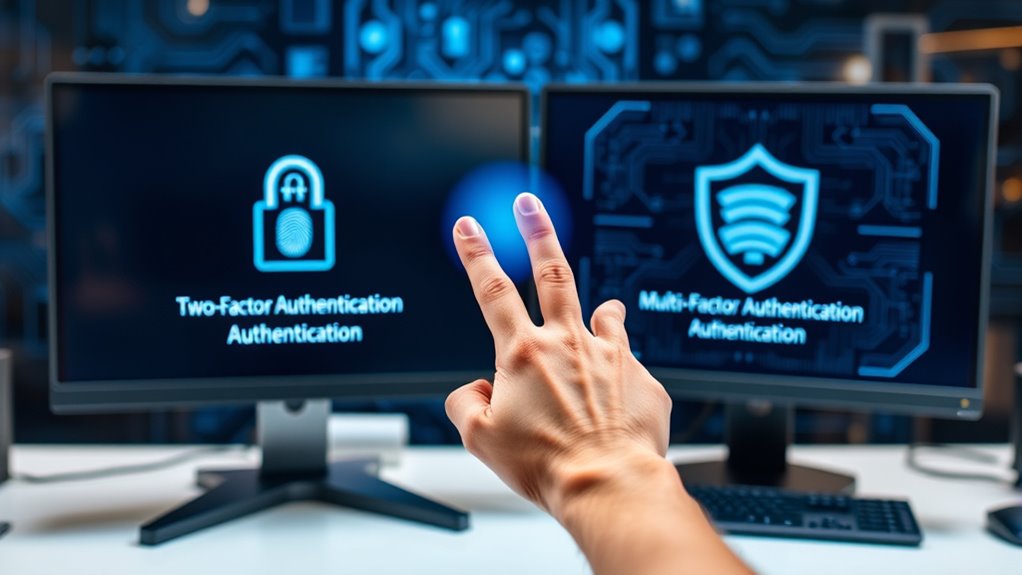
Understanding authentication methods is essential to grasp how security systems verify your identity. Traditional passwords often fall short due to vulnerabilities, prompting the rise of biometric innovations as reliable password alternatives. Fingerprint scans, facial recognition, and voice authentication now offer faster, more secure ways to access your accounts. These methods use unique biological traits, making them harder for hackers to replicate or steal. By integrating biometric innovations, organizations reduce reliance on memorized passwords, enhancing overall security. You benefit from quicker access and increased protection against common attacks like phishing or credential theft. As technology advances, these password alternatives become more seamless and user-friendly, transforming how you authenticate online without sacrificing security. Understanding these methods helps you make informed choices about protecting your digital identity.
The Components of Two-Factor Authentication
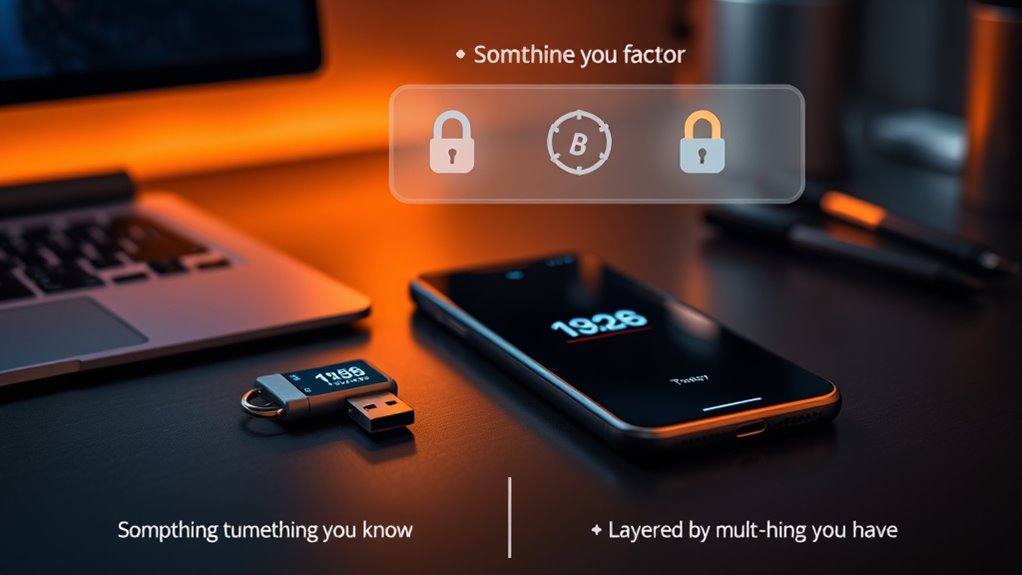
Two-factor authentication combines two different types of verification to protect your accounts. You’ll typically encounter various authentication factors, such as something you know, something you have, or something you are. Common methods include entering a password and confirming a code sent to your phone, making your login process more secure. Additionally, understanding the best anime movies can provide insight into diverse storytelling techniques that can inspire creative security solutions.
Authentication Factors Types
Authentication factors are the different types of evidence used to verify your identity during the login process. These factors include something you know, like a password; something you have, such as a security token; and something you are, which involves biometric integration. Biometric methods, like fingerprint or facial recognition, provide a high level of security because they rely on unique physical traits. Behavioral analysis is another emerging factor, monitoring your typical actions—typing patterns or navigation habits—to confirm your identity seamlessly. Combining these factors strengthens authentication, especially in two-factor setups. By utilizing biometric integration and behavioral analysis, you add layers of protection that are difficult for attackers to mimic or bypass, making your online accounts more secure. Additionally, vetted products ensure that the methods used are both safe and effective.
Common Verification Methods
After identifying the different types of authentication factors, it’s important to recognize how they are combined in practical security measures. Common verification methods include biometric identification, such as fingerprint or facial recognition, which offers quick and reliable access. You might also use password complexity, requiring a mix of letters, numbers, and symbols to strengthen security. These methods work together to verify your identity effectively. For two-factor authentication, you may need both a biometric scan and a password, adding an extra layer of protection. The combination of biometric identification and complex passwords makes it more difficult for attackers to breach your accounts. Understanding AI vulnerabilities and their implications can help you stay aware of potential security risks. By understanding these verification methods, you can better appreciate how multi-layered security enhances your online safety.
Exploring Multi-Factor Authentication

Multi-factor authentication (MFA) enhances security by requiring users to verify their identity through multiple methods. It often combines something you know, have, or are. For example, biometric integration uses fingerprint or facial recognition, making access quick and secure. Behavioral analysis tracks patterns like typing speed or device usage to identify anomalies. These methods add layers of protection beyond simple passwords. Consider the table below:
| Method | Description |
|---|---|
| Biometric | Uses physical traits like fingerprints or face |
| Behavioral | Monitors user habits for suspicious activity |
| OTP (One-Time Password) | Temporary codes sent via SMS or email |
| Security Questions | Personal info to verify identity |
Implementing diverse factors makes unauthorized access considerably harder, safeguarding your data more effectively. Regional legal resources can also provide guidance on security protocols and compliance standards to strengthen your overall protection.
Comparing Security Effectiveness
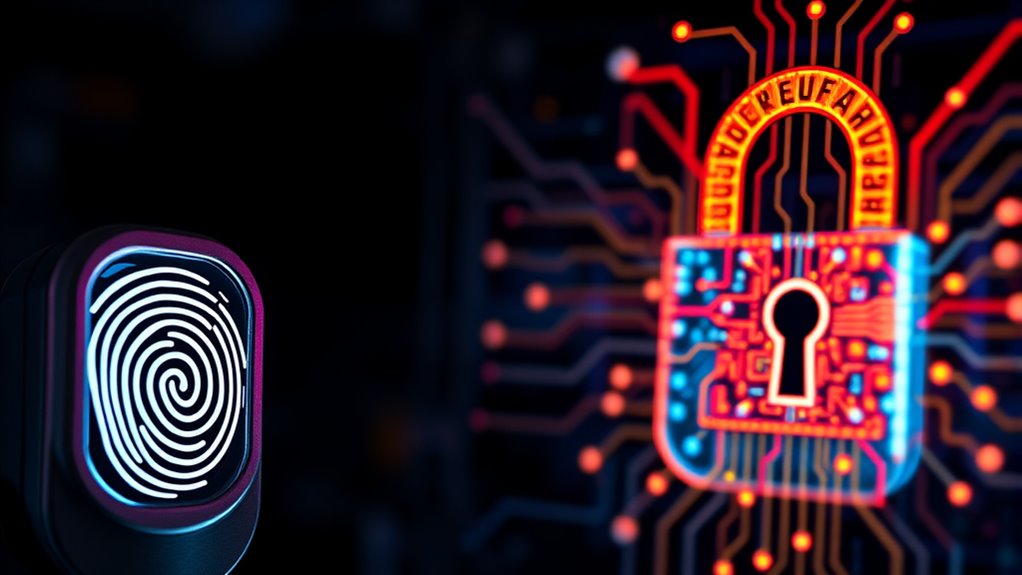
When comparing security effectiveness, you should consider how many layers of protection each method provides. Multi-factor authentication generally offers a stronger defense, but it can also impact user convenience. Evaluating threat resistance levels helps you determine which approach best balances security and usability for your needs. Additionally, understanding relationship dynamics can help inform how users may respond to different authentication methods and their potential vulnerabilities.
Security Layer Depth
Two-factor authentication (2FA) offers a notable improvement over single-factor methods by adding an extra layer of security, but it still leaves certain vulnerabilities open. For example, if a hacker gains access to your password or intercepts your authentication code, they could bypass 2FA. That’s why multi-factor authentication (MFA) boosts security further by combining different types of factors. Biometric innovations, like fingerprint or facial recognition, serve as strong password alternatives, increasing the security layer depth. These methods are harder to forge or steal, reducing reliance on traditional passwords alone. While 2FA provides better protection, MFA’s varied factors make it more resilient against attacks, ensuring your accounts are better shielded from unauthorized access. The more diverse your security layers, the more difficult it becomes for intruders to breach your defenses. Additionally, implementing methods like vertical storage solutions from home organization strategies can be likened to layering security measures, as they optimize space and reduce clutter that could potentially hide vulnerabilities.
User Convenience Balance
While adding more authentication factors enhances security, it can also affect user convenience. You might experience password fatigue, making it frustrating to remember multiple codes. To minimize inconvenience, systems often incorporate biometric shortcuts like fingerprint or facial recognition, allowing quick access without compromising security. Here are three key points:
- Biometric shortcuts streamline login processes, reducing time and effort.
- Password fatigue can lead users to bypass security, undermining protection.
- Balancing security and convenience involves choosing authentication methods that are both effective and user-friendly.
- Understanding the Golden Retriever breed’s friendly nature can help in designing more engaging security features for pet owners.
While multi-factor authentication boosts security, overly complex systems risk alienating users. Striking the right balance ensures you stay protected without sacrificing ease of use.
Threat Resistance Levels
Adding multiple authentication factors generally increases security by making it harder for attackers to gain unauthorized access. Multi-factor authentication (MFA) leverages biometric innovations like fingerprint scans or facial recognition to enhance threat resistance. These biometrics are harder to replicate or steal compared to traditional passwords, which have evolved considerably but remain vulnerable. Password evolution has led to longer, more complex passwords, yet they still face risks like phishing and brute-force attacks. MFA combines these advancements, creating layered security that’s more resistant to breaches. Two-factor methods offer a notable boost, but multi-factor systems add extra hurdles for cybercriminals. By integrating biometric innovations and improved password practices, you markedly strengthen your defenses against increasingly sophisticated threats.
User Experience and Convenience
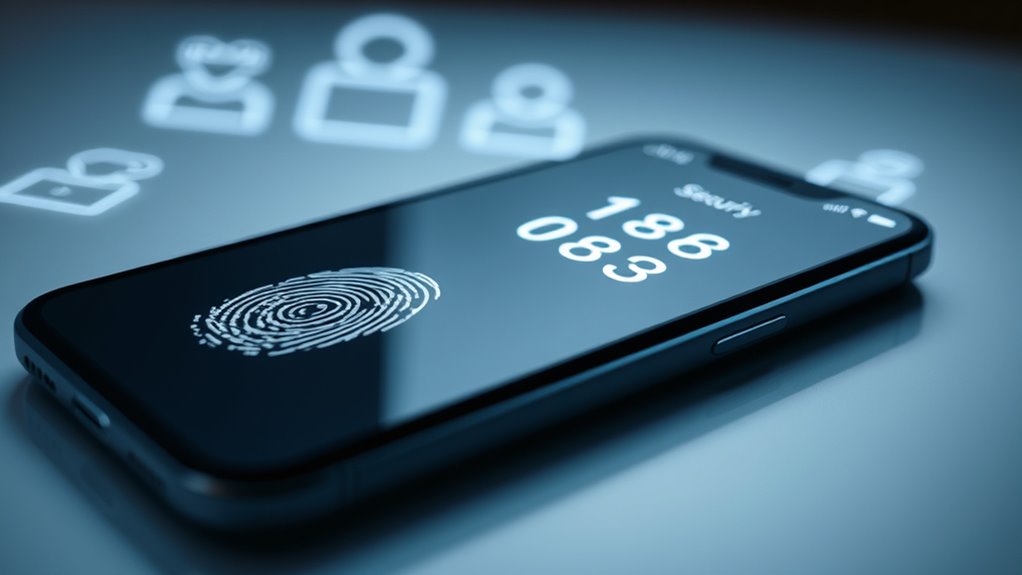
User experience and convenience play crucial roles in choosing between two-factor and multi-factor authentication methods. If security feels too cumbersome, you might face password fatigue, making it harder to stay vigilant. Multi-factor methods often require extra steps during user onboarding, which can slow you down initially. However, they offer better protection in the long run. Consider these factors: 1. Simple login processes reduce frustration and speed up user onboarding. 2. Too many authentication steps can lead to password fatigue, decreasing overall security awareness. 3. Balancing convenience with security ensures you’re not tempted to disable protections or seek shortcuts. 4. Incorporating remote work practices can influence the choice of authentication methods to maintain secure access across distributed teams. Ultimately, the right method depends on your priorities—whether smooth user experience or robust security matters most.
Implementation Challenges and Costs

Implementing multi-factor authentication often involves higher costs and more complex setup processes compared to two-factor methods. You need to conduct a thorough cost-benefit analysis to determine whether the added security justifies the investment. Multi-factor solutions typically require additional hardware, software, and staff training, increasing upfront expenses. Implementation complexities can also lead to longer deployment times and potential disruptions to your existing systems. You might face compatibility issues with current infrastructure or resistance from users uncomfortable with new procedures. While the security benefits are clear, understanding these challenges helps you weigh the financial and logistical impacts. Making an informed decision involves balancing the improved protection against the increased costs and complexity involved in deploying multi-factor authentication. Additionally, considering the planning and execution phase can help mitigate unexpected hurdles during deployment.
Use Cases and Suitable Scenarios

Choosing between two-factor and multi-factor authentication depends largely on the specific use case and security needs. For high-risk environments, multi-factor authentication offers stronger identity verification and access management. Consider these scenarios:
- Corporate networks: Multi-factor authentication helps prevent unauthorized access by requiring multiple forms of verification, protecting sensitive data.
- Online banking: Two-factor authentication often suffices here, balancing security with user convenience in verifying identities.
- Healthcare systems: Multi-factor authentication ensures robust identity verification, safeguarding patient records and complying with regulations.
- Recognizing patterns in angel numbers can guide security strategies, as they signal the importance of aligning your authentication methods with evolving threats.
In each case, the level of security required guides your choice, guaranteeing access management aligns with potential threats and compliance standards.
Future Trends in Authentication Technologies

As technology advances, authentication methods are rapidly evolving to become more secure and user-friendly. Biometric evolution is driving this change, with fingerprint scanners, facial recognition, and voice authentication becoming more accurate and widespread. These biometrics reduce reliance on passwords, enhancing security and convenience. Additionally, blockchain integration promises to revolutionize authentication by providing decentralized, tamper-proof verification systems. This technology enables secure identity management without centralized databases vulnerable to hacking. Future trends also include multi-layered approaches combining biometrics, blockchain, and behavioral analytics for robust security. As these innovations mature, you’ll benefit from faster, more seamless authentication processes that protect your data while simplifying access across devices and platforms. The future of authentication is about making security invisible and effortless for you.
Frequently Asked Questions
How Do Authentication Methods Impact User Privacy?
Authentication methods directly affect your privacy by handling sensitive data like biometric information and requiring data encryption. When you use biometric authentication, your biometric privacy is at stake, so strong encryption safeguards your data from breaches. Different methods may collect varying levels of personal info, impacting your privacy. Active security measures help guarantee your data remains confidential, giving you peace of mind while accessing services securely.
Can Multi-Factor Authentication Be Bypassed?
You might wonder if multi-factor authentication can be bypassed. While it’s more secure than single-factor methods, vulnerabilities exist. Biometric vulnerabilities, like fingerprint or facial recognition hacks, can be exploited. Additionally, credential reuse across sites increases risks if passwords are stolen. Attackers may also bypass MFA through social engineering or session hijacking. So, while MFA greatly enhances security, it’s not entirely foolproof against sophisticated attacks.
What Are the Legal Implications of Different Authentication Methods?
When considering authentication methods, you need to think about legal compliance and liability risks. Different methods, like passwords or biometric data, may have specific legal requirements depending on your industry and region. Using weaker methods could increase your liability if a breach occurs, while stronger multi-factor authentication can help protect sensitive data and guarantee compliance with regulations. You’re responsible for choosing secure methods to minimize legal risks and meet legal standards.
How Do Organizations Decide Between Two-Factor and Multi-Factor Authentication?
You might think choosing between two-factor and multi-factor authentication is straightforward, but organizations often investigate security needs first. They weigh user experience—since more steps can frustrate users—against implementation costs, which can be high for multi-factor systems. Typically, if sensitive data or compliance requirements are involved, they opt for multi-factor. Otherwise, two-factor provides a good balance of security and convenience, aligning with their risk management strategy.
Are There Emerging Technologies That Could Replace Current Authentication Methods?
You might wonder if emerging technologies could replace today’s authentication methods. Biometric advancements, like fingerprint and facial recognition, are becoming more accurate and widespread, offering seamless security. Blockchain authentication introduces decentralized, tamper-proof systems that could enhance trust and reduce fraud. These innovations hold promise for replacing or supplementing current methods, making authentication more secure and user-friendly as technology continues to evolve.
Conclusion
Choosing between two-factor and multi-factor authentication is like picking the right shield for your digital fortress. While two-factor offers solid protection, multi-factor adds extra layers like a well-armed castle. Consider your needs, balance security with convenience, and stay ahead of threats. Remember, in the ever-evolving landscape of cybersecurity, staying vigilant is your best armor. Protecting your digital world isn’t just a choice—it’s a smart investment in your peace of mind.
